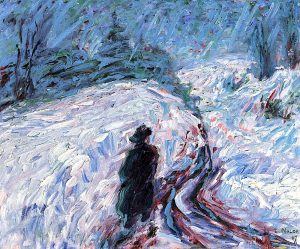
Emil Nolde’s “Winter,” 1907.
Nolde uses visual elements to their full potential in his 1907 oil piece, Winter. It is through color, stroke, and line that he establishes an expressive struggle between man and nature.
Stroke and Line
The power of nature is emphasized through the contrasting strokes and directional lines. The choppy, chaotic brushstrokes lend depth, power, and weight to the snow that breaks it up from the typical, flat placidity of a freshly fallen blanket and imbue it with energy. Note, also, the slanted strokes dominating the sky. Mimicking precipitation, as if snow or sleet were falling, the strokes encourage other senses: wet precipitation, cold wind, slippery roads, all effects of the planet’s natural cycles. Directional lines ensure that this scene is one of action. The horizon slants up to the right, creating a hill and a journey for this man to face. Most striking, however, is the inclusion of contrasting lines and strokes to really send this piece spiraling. Evergreens made of horizontal strokes contrast the tall, vertices branches of dead trees; the road wanders up from the bottom right, bisecting the horizon and blending into the mass of trees. These contrasts indicate that nature is not easily categorized or tamed; it is full of elements that will move their own way regardless of the rigidity of man, for he is but a small, vertical mark with smoother strokes than the world around him.
Color
Color is used to indicate the contrast between man and nature and the impact of them upon one another in Nolde’s Winter. The blatant contrast between a man dressed in black and the snow he trudges through is quite jarring; this man becomes the focal point, quickly drawing the eye from the lighter and more muddled background. I say muddled because it is important to note this additional contrast–the man’s colors are simple, having just a slight highlight on one side, whereas the landscape is composed of a myriad of blues, whites, greens, browns, pinks, purples, reds, and blacks. The road is largely a muddied brown that contaminates the snowbanks around it; it is an unpleasant stain that divides, but disappears into the landscape that it dirties. Yet, the sheer amount of landscape colors, however multicolored, dwarf the man and his path. The impact of the man and road’s presence is strong, but it cannot compare to the power of the landscape.

